Fun Facts About Galaxies
Written by Aindrila Jana, writer
There are some two trillion galaxies in the observable universe…
Written by Aindrila Jana, writer
Do you like to know facts about galaxies and other space stuff? Here’s an article for you!
What we’ll look at today
The universe
Types of galaxies
Known galaxies in our universe
Fun Facts
About our Milky Way
Where are galaxies found
Who discovered galaxies
Before we get to know all facts about galaxies, let’s start with the basics.
What is a Universe?
The Universe is pretty much everything – space, time and all that goes in it – like gases, energy and matter, planets, stars and galaxies.
A galaxy is any of the systems of stars and interstellar matter that make up the universe. And, here’s the thing – the universe contains billions of galaxies in galaxy clusters which are basically groups of galaxies. There could be thousands of galaxies in one galaxy cluster. And, these clusters are themselves a part of massive superclusters.
Our galaxy, the Milky Way, is located in a small galaxy cluster called the Local Group which is said to have some 30 galaxies (more on the Local Group later in this article)
But, before we get into more details about galaxies, here’s what you need to know and understand..
The Universe is very, very big – bigger than we can imagine. One of the things that make up the universe is billions and trillions of galaxies. Our galaxy (in which our Solar System is) belongs to a galaxy called the Milky Way.
Good so far?
Ok now, this is where it gets a little bit more complex.
Our galaxy is part of a bigger group of galaxies, called the Local Group.
And The Local Group, in turn, is part of an even bigger group named the Local Supercluster, which is sometimes also called the Virgo Supercluster.
So, here’s a loose order that explains where our Earth is in this universe
- The Universe
- Galaxy Super Clusters – ours is called Local/Virgo Super Cluster
- Galaxy Cluster called The Local Group
- Milky Way
- Earth
- Milky Way
- Galaxy Cluster called The Local Group
- Galaxy Super Clusters – ours is called Local/Virgo Super Cluster
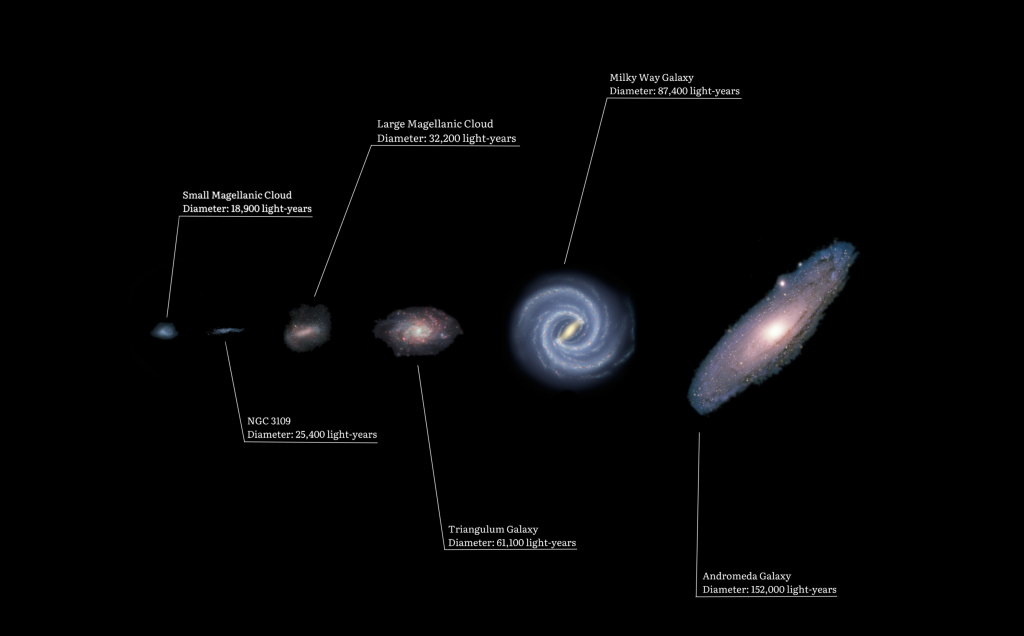
Ok, so now we get into details and know facts about galaxies.
What’s a galaxy?
Simply put a galaxy is a collection of stars, planets, dust, and dark matter, held together by gravity, which makes up a universe
Galaxies come in various shapes and sizes. Most large galaxies are believed to contain supermassive black holes at their centers.
So, how many galaxies are there?
Hard to put a number, but a 2016 study estimates that the observable universe contains around two trillion galaxies!
So, we live in one of 2 trillion galaxies! Let that sink in!
Let’s first understand the types of galaxies out there.
Types of galaxies
Galaxies are classified into three main major categories: Elliptical, Spiral, and Irregular (our galaxy, the Milky Way is part of the Spiral kind)
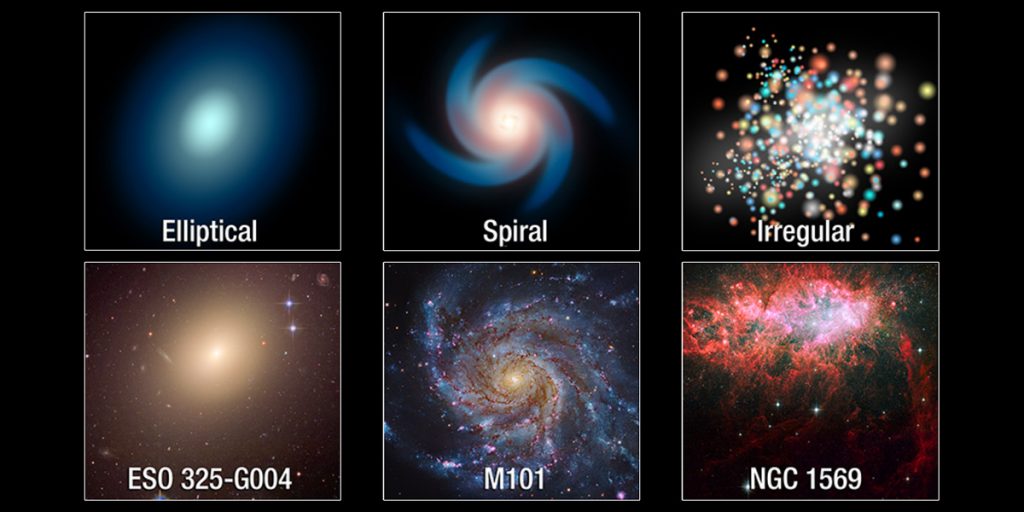
Image Credit: A. Feild (STScI) – via NASA
These come in a wide range of sizes – from those containing 100 million stars to giant ones that have some trillion stars!
Spiral Galaxies
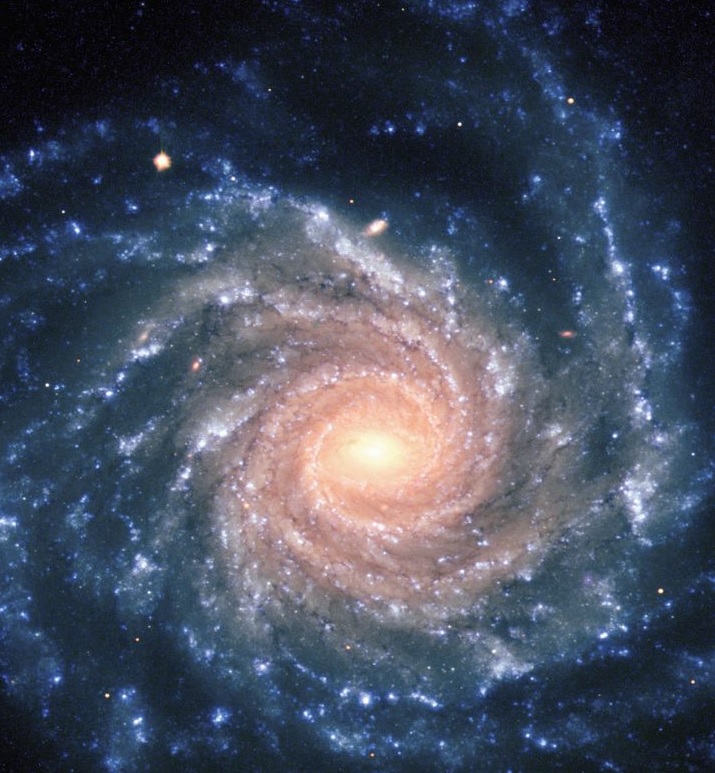
Image Credit: European Southern Observatory
A spiral galaxy has a rotating disc at the center with long ‘arms’ curving out of a dense central region. The center of a spiral galaxy comprises older stars while the arms generally comprise new stars.
- Many spiral galaxies contain a massive black hole at the center.
- Spiral galaxies are generally the brightest galaxies in the entire universe.
- They are the most common type of galaxies found in the Universe. Around 60% of the observable universe is made of spiral galaxies. The Milky Way Galaxy and the Andromeda Galaxy are two spiral galaxies.
- Spiral galaxies were originally described by eminent astronomer Edwin Hubble in his work titled The Realm of the Nebulae.
Elliptical Galaxies

www.flickr.com/photos/nasahubble
Generally found in clusters, elliptical galaxies have smooth ellipsoidal or spherical appearances. Elliptical shape generally refers to something that is oval in shape, so that’s what these galaxies roughly are shaped like.
- They generally contain a larger proportion of older stars than spiral galaxies do.
- The eight main types of elliptical galaxies include E0, E1, E2, E3, E4, E5, E6, and E7. E0 generally has an almost perfect circular shape, whereas E7 is stretched out. They are the two extremes of the spectrum and other types are included in between them.
- The elliptical galaxy IC 1101, with an estimated diameter of 2,000 kilo light-years, is the largest galaxy discovered in the observable universe.
- Maffei 1 is the closest elliptical galaxy to Earth.
Irregular Galaxy
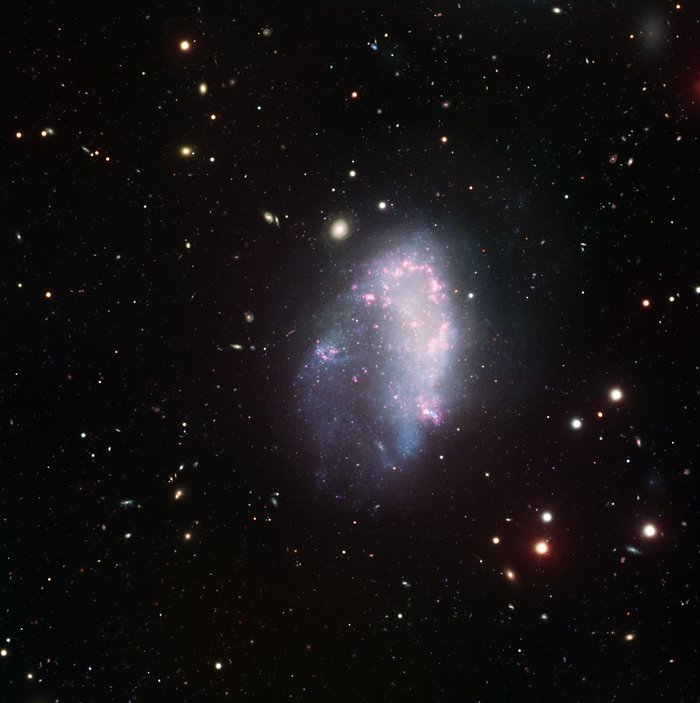
Image Credit: European Southern Observatory
As the name suggests, irregular galaxies have no distinctly particular shape. They neither have any noticeable symmetry nor a central nucleus.
- They primarily constitute the smallest galaxies in the universe and are filled with gas and dust. Hydrogen is the main gas that irregular galaxies are composed of. The formation of new stars needs hydrogen gas, as its main component. Hence, irregular galaxies are responsible for the formation of new stars and this makes them appear very bright.
- About 20% of all galaxies are found to be irregular galaxies.
- Since they do not have a determined size, they are commonly called dwarf irregulars.
- The Large Magellanic Cloud is a renowned example of an irregular galaxy.
Then there are those in between…
Galaxies that are intermediate between elliptical galaxies and spiral galaxies are called Lenticular Galaxies.
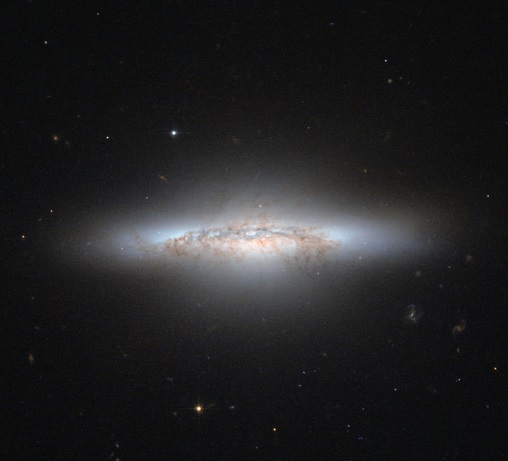
Taken by the Hubble Telescope
In terms of shape, these galaxies have a central bulge that lies in between a flattened disk and have no spiral arms. Lying about 50 million light-years away in the constellation of Canes Venatici, NGC 4111 is a lenticular galaxy.
Lists of Known Galaxies in the Universe (the universe we know that is)
So, here’s what you need to know before you read on.
The list below is the list of those galaxies that we know about that exist in this universe. There are other universes that we don’t know of that will have galaxies too! Yup, it’s a little confusing!

Ok, so here goes..the list of galaxies we know of, in the universe we know!
Let’s start with our own galaxy – the Milky Way.
1. The Milky Way
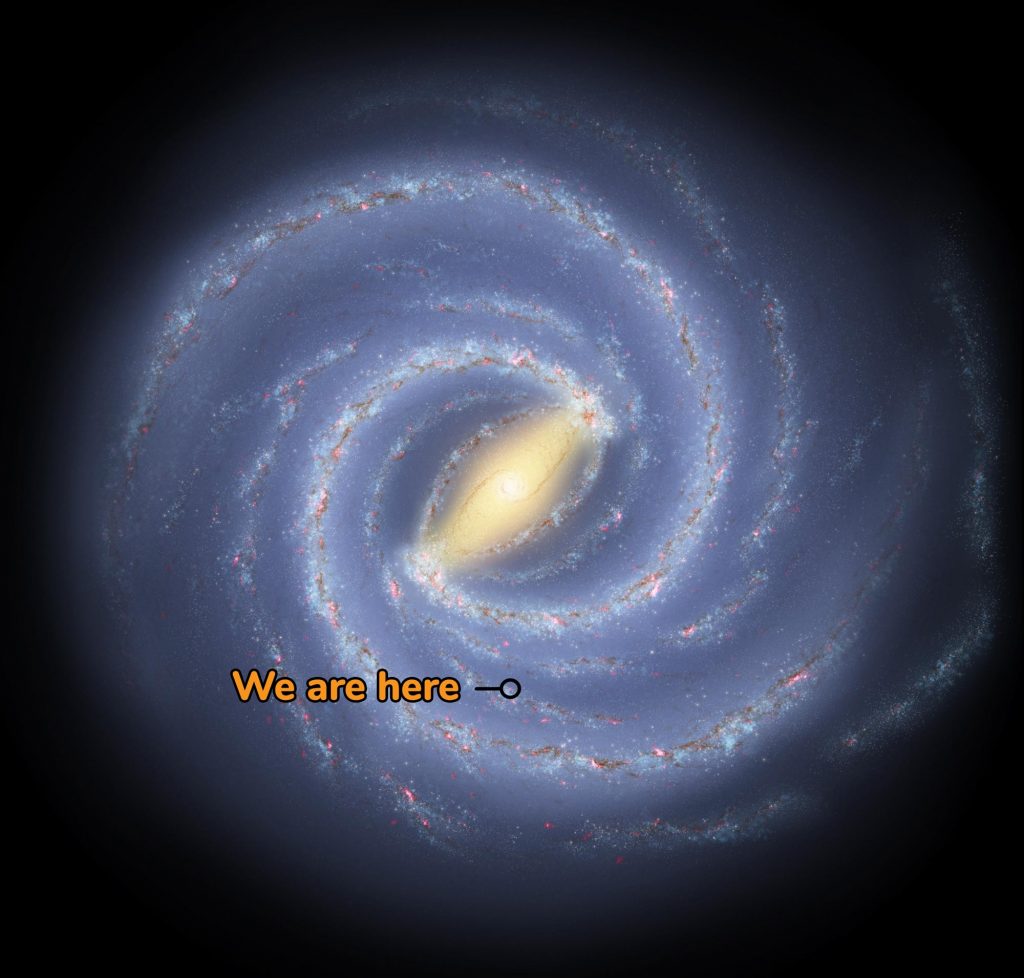
American Museum of Natural History
This is our very own galaxy that contains our Solar System. The name describes the galaxy as it looks like from Earth – a hazy band of light that looks like milk spilled across the sky.
The words Milky Way come from the Latin words, via lacteal, meaning, “milky road” or “milky way.” It was the famous Italian astronomer, Galileo Galilei, who used his telescope in 1610 to tell us that this milky band of light was made of individual stars.
The Milky Way has hundreds of billions of stars, much like our sun. Our Earth is somewhat halfway between the center of the Milky Way and its outer edge.
Here’s a super fun fact that you may not have known
Say you wanted to travel to the center of the Milky Way (we are at the outer edge) – so even if you travelled at the speed of light (300,000 kilometers per second), it would take you about 25,000 years to reach the center!
So HOW big is our Milky Way exactly?
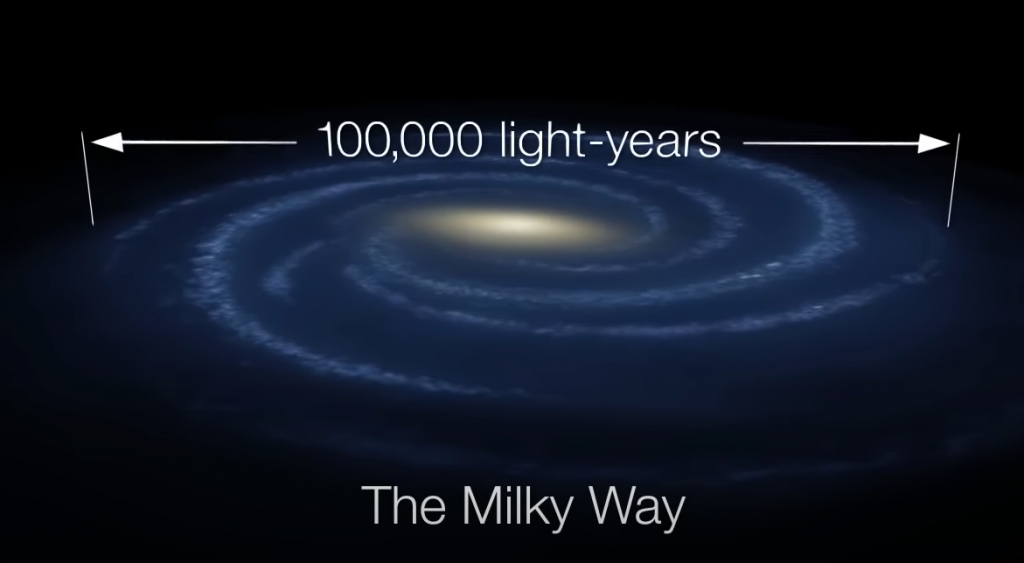
It’s about 100,000 light-years across.
What’s a light year?
A light-year has nothing to do with time, it’s actually used to measure distance in space – makes it easier. So, one light-year is the distance that light travels in a single Earth year, which comes to about one trillion miles or approximately 9.7 trillion kilometers.
And we just told you that our Milky Way Galaxy is 100,000 lights years across..so now multiply that by one trillion miles – that’s how big it is!

And, scientists believe that our galaxy has between 100 to 400 billion stars!
Black holes
Black holes lie at the center of our Milky Way. These are created when a giant star dies after running out of energy. The star kind of blows up and causes a massive explosion that’s called a supernova.
2. Andromeda Galaxy
A spiral galaxy, this is the closest to our Milky Way.
Location: About 2.5 million light-years from Earth.
The rest are:
3. Black Eye Galaxy
Also called the M64, this galaxy has a unique motion that sets it apart from all else – the gas in its outer regions rotates in the opposite direction from the gas and stars in its inner areas!
4. Bode’s Galaxy
A spiral galaxy.
Location: About 12 million light years away.
5. Cartwheel Galaxy
This is a lenticular and ring galaxy (remember we told you what a lenticular galaxy as above).
Location: About 500 million light-years away. Looks like a cartwheel, hence the name
6. Cigar Galaxy
A starburst galaxy.
Location: About 12 million light-years away
The rest are: Comet Galaxy, Cosmos Redshift, Hoag’s Object, Large Magellanic Cloud, Small Magellanic Cloud, Mayall’s Object, Pinwheel Galaxy, Sombrero Galaxy, Sunflower Galaxy, Tadpole Galaxy and Whirlpool Galaxy.
Top 20 Fun Facts About Galaxies In 2022
1. There are more than two trillion galaxies discovered in the observable universe the size of which scientists have calculated to be 46 billion light-years. Beyond that lies the unobservable universe.
2. The diameter of most galaxies is between 1,000 and 10,000 parsecs – (approximately 3,000 to 300,000 light-years)
3. The most distant galaxy ever discovered was approximately 13.1 billion light years away and named z8 GND 5296. A team of astronomers from the University of Texas at Austin discovered it.
4. Our Sun is located in, what’s called, the Orion Arm of the Milky Way Galaxy.
5. A galaxy with an unusually high amount of gas and dust, which results in an exceptionally high rate of production of stars is called a Starburst Galaxy. An example of a starburst galaxy is Messier 61.
6. The Milky Way Galaxy has a “galactic halo” surrounding it on its perimeter and it is composed of clouds of gases containing clusters of stars.
7. Due to the strong gravitational pull from its neighboring two galaxies, the Milky Way Galaxy is currently growing in size.
8. The Antennae Galaxies are a pair of interacting collided spiral galaxies in the constellation Corvus.
9. Our galaxy, the Milky Way Galaxy, approximately contains around 100 to 400 billion stars and is about 100,000 light-years across. IC 1101 is the largest known galaxy in the Universe and it is about 6 million light-years across. It is so big that it can fit over one million Milky Way galaxies inside it!
10. On average, the number of stars in a galaxy ranges from a hundred billion to a trillion stars! And each star in a galaxy contains its own planetary system, which adds up to billions of planets in the universe.
11. The force of gravity is what holds a galaxy together. Stars do not fly into space and planets do not deviate from their orbits because of the gravitational force that keeps everything held together inside a galaxy.
Now, some fun facts about the Milky Way
12. The Milky Way Galaxy is actually warped! Its disk is not perfectly flat, it is warped due to two of our neighboring galaxies, that is, Large and Small Magellanic clouds and they have been pulling the matter in our galaxy towards themselves like a tug-of-war game!
13. The Milky Way Galaxy is a part of a cluster of galaxies called the Local Group, which contains around 40 galaxies. The Local Group is a part of the Local Supercluster that contains several clusters of galaxies.
14. In accordance with the Cosmic Microwave Background Radiation, the Milky Way Galaxy travels across space at a speed of about 343 miles per second.
15. Sagittarius A is a supermassive black hole situated in the galactic core of the Milky Way Galaxy. The mass of roughly 4.3 million Suns adds up to its mass.
16. The Milky Way Galaxy is called the Silver River by the Chinese. Chinese mythology states that this Silver River was put there by the gods to deter a herdsman who was in love with a weaver woman. The Romans call it the Milky Road as our galaxy reminded them of milk. It is called Akash Ganga in India which literally means “Ganga of the Heavens.”
17. The Milky Way Galaxy has a halo of dark matter which makes up about 90% of its mass. We can see less than 10% of its mass, even via a telescope.
18. Research states that there are at least 100 billion planets present in our galactic home.
19. The Andromeda Galaxy and the Milky Way Galaxy are traveling towards each other at the speed of about 250,000 miles an hour and both will collide in around 5 billion years!
Where are galaxies found?
Galaxies are found in groups and clusters, as we’d mentioned above.
Our Milky Way Galaxy is located in a group of about 30-40 galaxies, and this group is called the Local Group
The Local Group
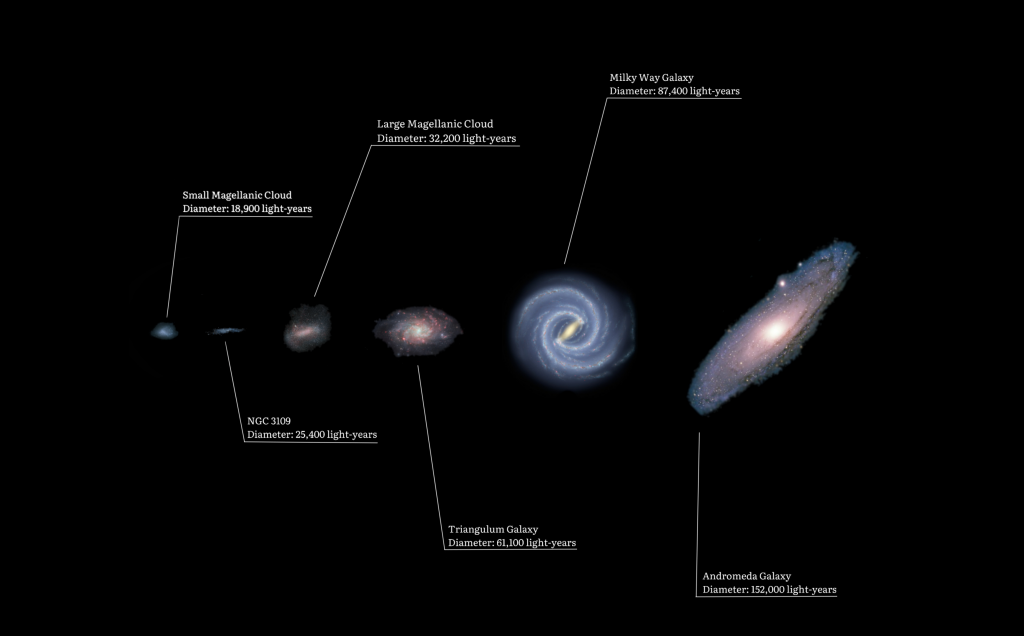
By SkyFlubbler – Own work, CC BY 3.0, https://commons.wikimedia.org/w/index.php?curid=122616421
The Local Group’s size is about 10 million light-years in diameter.
Here’s what the Local Group is primarily made of:
Three Large Spiral Galaxies – The Andromeda galaxy, The Triangulum Galaxy, The Milky Way
Many Dwarf planets
Our Milky Way is not the biggest in this group – it’s one of the three biggest. The Andromeda galaxy, as we mentioned earlier, is the biggest in the Local Group. The other is Triangulum Galaxy. All three are spiral galaxies.
Our group also contains about 50 dwarf galaxies – which are basically smaller galaxies with fewer stars than the bigger ones.
The Local Group is mostly made of elliptical galaxies (about half) – the others are spiral or irregular ones.
Astronomers believe that the galaxies in the group are held together by a mutual gravitational force.
Some names in our Group…
There are dwarf spheroidal galaxies, like Sculptor and Fornax. Then there are two more well-known dwarf galaxies called the Large Magellanic Cloud (LMC) and Small Magellanic Cloud (SMC) – these are among the closest galaxies to Earth, though much smaller than our Milky Way.
The Large Magellanic Cloud, for instance, has 1/10th of the brightness of the Milky Way Galaxy suggesting that it has about 10% of the mass of the Milky Way Galaxy. Some of the smallest dwarf galaxies in the Local Group have 1/50,000th the brightness of the Milky Way Galaxy.
Thus, although the dwarf galaxies are much higher in number in the Local Group, the three spiral galaxies dominate the mass of the Local Group.
Other Group and Cluster Galaxies
Moving outward from the Local Group, we encounter several other groups that are apparently similar to our own.
Centaurus A is a member of the M83 group and it is about 5 Mpc away.
(mpc stands for megaparsec, which is, in terms of distance, is equal to one about 3.26 million light years). The M81 group, which contains more than 40 galaxies situated at a distance of 12 million light-years from Earth, is one of the closest galaxy groups to the Local Group.
Since these groups of galaxies are not densely packed together, the Local Group, the M81 group and the M83 group are also called “loose groups“.
The Virgo Cluster
A much larger group of galaxies is located about 17 Mpc away from the Milky Way Galaxy and it is known as the Virgo Cluster. Our Milky way lies on the outskirts of this cluster.
Found inside the constellation Virgo, it contains approximately 2,500 galaxies. It is not much larger than the Local Group and is about 3 Mpc in radius.
But the galaxies inside the Virgo Cluster are very densely packed in their inner region and getting farther away from the center, the density decreases. Hence, the central core conditions of the Virgo Cluster are different from those in the Local Group.
Who discovered galaxies?
In the 17th Century, French astronomer Charles Messier identified the first galaxies, although he did not know what they were at that time.
He was a keen observer of comets and he spotted a number of hazy objects in the sky which he knew for sure that they were not comets. He was worried that the other comet researchers might be confused in the same way, hence to prevent their misidentification, he compiled a list that contained information about 110-star clusters and “spiral nebulae”. But it took almost 300 years for astronomers to figure out what these spiral nebulae actually were.
Some people argued that these spiral nebulae were “island universes” – objects similar to our Milky Way galaxy, but located externally. Many disagreed and they said that these were simply clouds of gas within the Milky Way Galaxy.
The argument continued without a confirmed answer until the 1920s when the American astronomer Edwin Hubble ultimately measured the distance to one of these spiral nebulae.
Edwin Hubble’s invaluable contribution!
The primary view among astronomers in the 1920s was that the Milky Way galaxy was the only galaxy in the only universe.
The Milky Way has at least a hundred billion stars, so astronomers thought that what they saw in the sky were parts of our own galaxy.
Until..
Edwin Hubble started digging…
Hubble was fascinated and equally confused by, what we now know as the Andromeda galaxy – it looked like a fuzzy spiral thing in the night sky. This was a time when it was firmly believed that Andromeda was part of our Milky Way. Astronomers believed that it was a nebula.
Hubble was not so sure. He and some others from an observatory at the University of California in the United States believed that there was something amiss.
Hubble’s study led him (and the others) to believe that Andromeda was its own, what they called an “island universe,” with its own stars.
This theory was met with a lot of opposition from other scientists as it challenged established theories about the universe.
Hubble proved it..
Edwin Hubble worked endless nights, taking photographs of Andromeda with a big telescope. and finally proved (with a complex set of calculations) that Andromeda was indeed a galaxy and not part of our Milky Way.
Discovery of the Milky Way Galaxy
Ancient Greek philosophers had proposed a long time ago that the Milky Way Galaxy was a vast collection of stars.
But the first real proof came to light when Galileo Galilei, an Italian astronomer, pointed at the Milky Way with his rudimentary telescope in 1610, and was able to identify that it was made of countless stars. He described the Milky Way Galaxy as “congeries of innumerable stars grouped together in clusters too small and distant to be resolved into individual stars by the naked eye.”
Later, Immanuel Kant, a German philosopher, 1755, proposed that the Milky Way Galaxy was a huge collection of stars held together by mutual gravity. William Herschel, a German-born British astronomer, had also attempted to map out the shape of the Milky Way Galaxy in 1785.
That’s a lot about galaxies for you! The information above, only mentions a rough sketch of galaxies – there are trillions of them. we only give you a basic outline here.
You May Also Like:
Why Are Planets Round
Interesting Facts About Solar Systems
Things to know about Neptune In 2023

Better Your Child’s G.K. In 3 Minutes – Get This Free Newsletter
Get fun facts, simple and easy news, quizzes, and lots of other interesting things to read in your mailbox – for free! It’s what we call GK-on-the-go!
I Kid You Not now has a large readership across India and also parts of the world. If you want to write for us, you can submit your story here. You can also apply to become a news anchor. Apply here



Comments